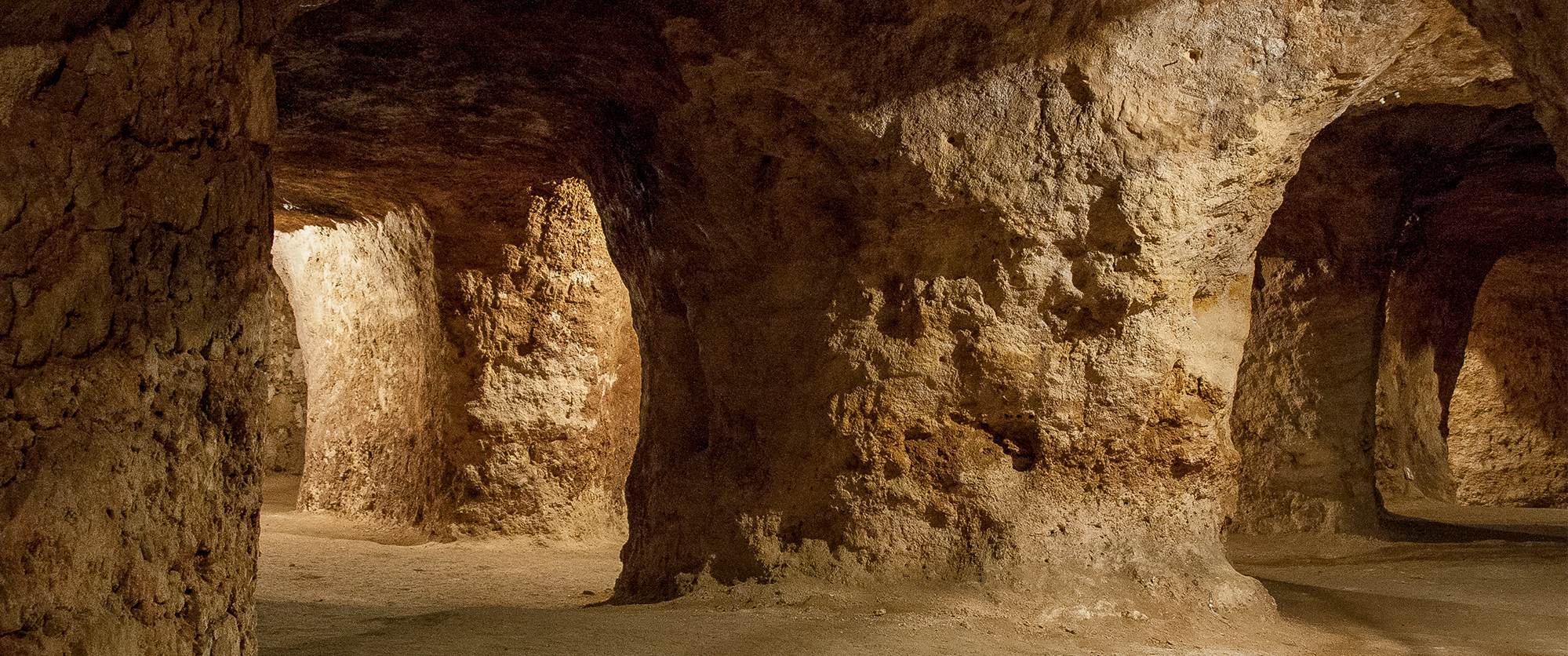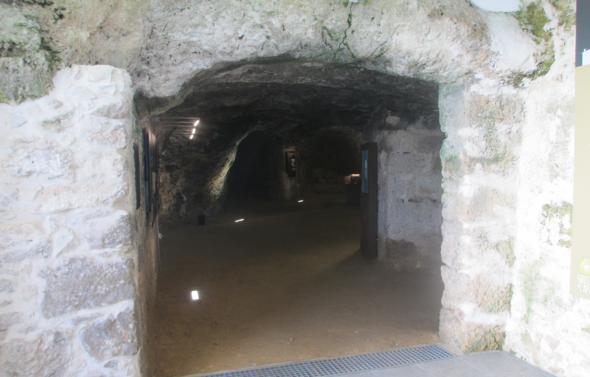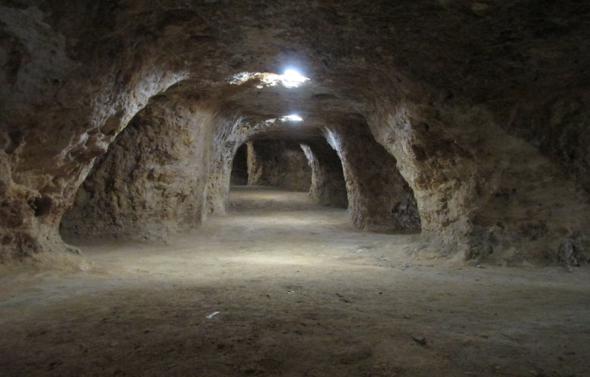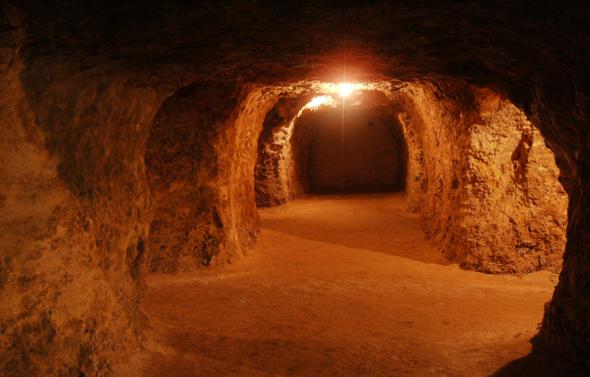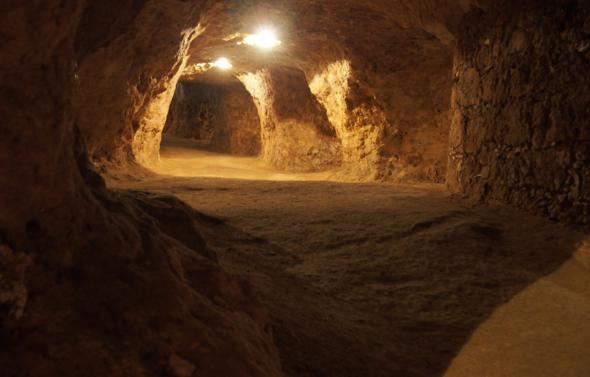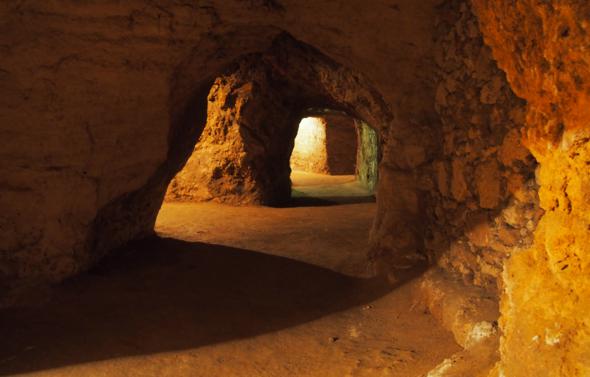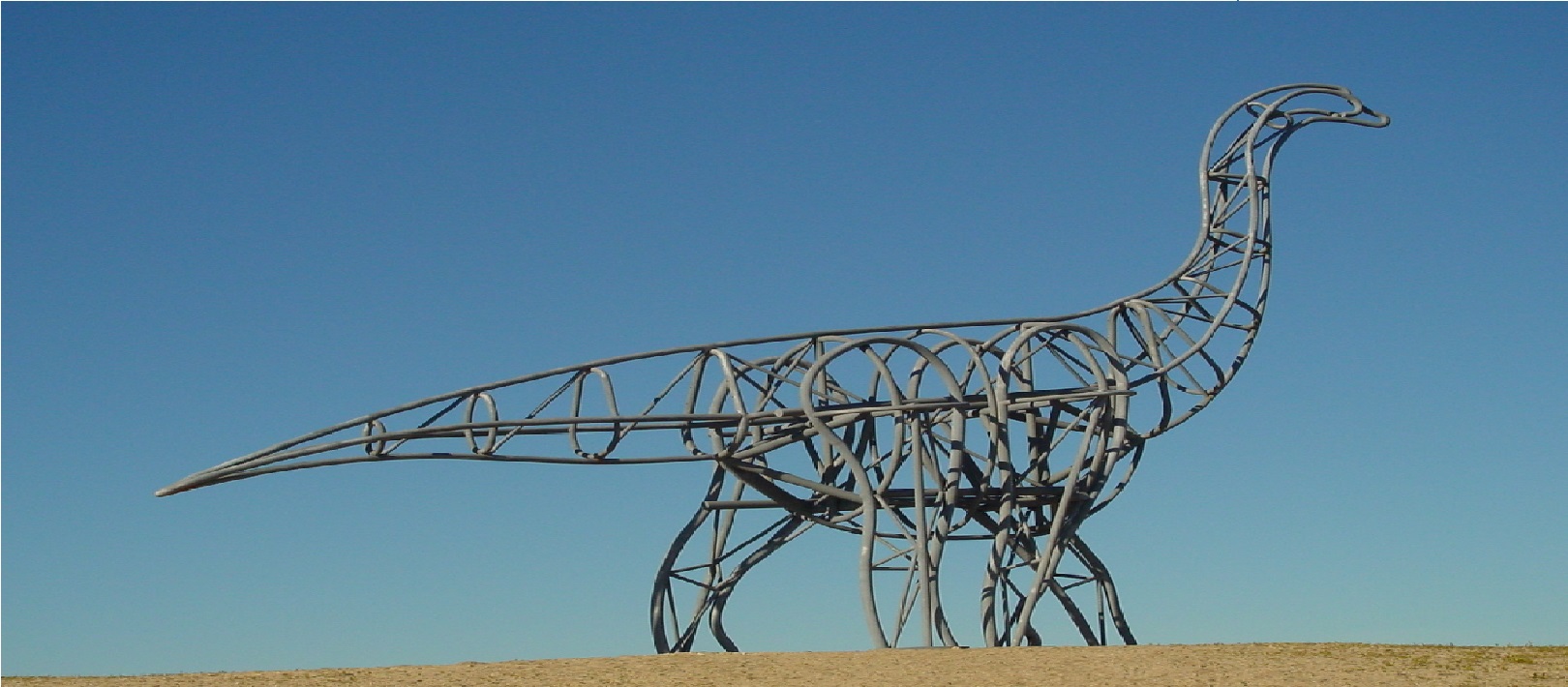The Caves of Coin Scientific and environmental interpretation Centre (CICA gm) is characterized by being an informative, didactic and scientific space. It is a place where students, tourists and public in general can find answers to the mul ...
Lapas Caves, Lapas
Lapas Caves are a network of artificial galleries developed beneath the houses of the village with the same name. This urban area has been raised in a small elevation corresponding to a fluvial terrace of Almonda river, from the Quaternary, composed by a specific geological material, the calcareous tufa. As it was easy to cut, this material was widely used in building construction for several centuries across the region. the origin of the caves remains a big mystery. Perhaps it eas a big tufa underground quarry, but there are no effetive elements to date it. several theories have been formulated: primitively used as shelters in natural cavities that could preexist, or places of refuge to early Chistians or even a tufa extraction station in the Roman Era. There are also references to the Moorish times in the legens... For sure one knows that the village was already named as Lapas in 1212 [a Portuguese word that mans small caves in a rock], as it appears in the foudation date of Lapas Brotherhood. The oldest materials found during the archeological works are from the 15th century and there are document sources from the 18th century referring the galleries as already abandoned. This is certainly one of the most singular heritage places in the country. You cam walk inside a fluvial terrace, get to know better the calcareous tufa and understand the particular interaction between the galleries and the medieval village raised on its top, among other historical facts and local characteristics. Engage yourself in this unnique environment and make your own theory about what happened here.
CHARACTERISTICS
City: Lapas
Postal Code: 2350 - 124
Telephone: 919527728
Email: geral@cm-torresnovas.pt
Website: http://www.cm-torresnovas.pt
monday, tuesday, wednesday, thursday, friday
From 13:00:00 to -.
From 18:00:00 to -.
Weekend and Holidays Schedule:
From 10:00:00 to 13:00:00.
From 14:00:00 to 18:00:00.
Exceptions:
Christmas Day; January 1st; May 1st
Paid Entry:
0€
Discount Policy:
-
Specific Conditions:
-
Method:
A pé
Difficulty Level:
Baixa
Group Visits:
Yes
Minimum Number of Person per group:
10
Maximum Number of Person per group:
50
Observations:
-
Guided Tours:
Yes
Observations:
Por marcação prévia, mediante disponibilidade.
Museums
-
Activity Program:
-
Study and Research Unit:
-
Audiovisual and Multimedia Resources:
-
Volunteering Programs:
-
Às voltas de Lapas. Com recurso a um tapete criado a partir das ilustrações do livro "Lapas as grutas que não são grutas", faz-se a leitura da história e exploram-se com os alunos as várias hipóteses sobre a origem daquelas grutas e o que estas galerias artificiais podem ou não ter sido. A leitura da história e a exploração do tapete permitem-nos conversar com os professores e alunos sobre estas galerias artificiais, sobre a sua possível origem e evolução.
Target Audience:
Básico. 1º ciclo.
Activity Cost:
0€
Weekly Schedule:
From 00:00:00 to 00:00:00.
From 00:00:00 to 00:00:00.
Weekend and Holidays Schedule:
From 00:00:00 to 00:00:00.
From 00:00:00 to 00:00:00.
Exceptions:
Ao longo de todo o ano letivo. Uma turma, uma sessão. Duração 00:50. Local da ação: Bibliotecas Escolares do concelho. Biblioteca Municipal de Torres Novas.
Observations:
Obra apresentada: Lapas as grutas que não são grutas! de Jorge Simões e Alexandra Sirgado (edição do Município de Torres Novas) Património cultural e natural; Lapas; Geologia; Grutas.
T. Rodoviário
Agency Name:
Transportes Urbanos Torrejanos (TUT) - Rodoviária do Tejo
Telephone Number:
249810700
Parking for private vehicles:
Yes
A national monument since 1910, this 12th-century Arab fortress as definitely conquered in 1190 by D. Sancho I. Surrounded by a all of eleven toers and the house of the mayor (14th century), the castle has, ithin the alled enclosure. , a garden. It underent several reconstructions, most notably those of D. Sancho I, D. Fernando, and the one made on the occasion of the centenary celebrations of Independence and Restoration (1940).
gps: 392845.8 83225.4
distance: 2km
Church of Our Lady of Grace
It is located in the center of the village of Lapas. Built in 1550 by Marcos Lopes, it as rebuilt in 1883 and expanded in 1963. The blue and yello seventeenth-century tiles of the nave and choir stand out. The triumphal arch of the chancel is flanked by to altars ith seventeenth-century gilded altarpieces, and on the right side is the ooden image of Our Lady of Victory ith the Child, said to have been found in the Caves of Limpets.
gps: 392933.8 83312.8
distance: 0km
Natural Monument of the Dinosaur Footprints
6 km from the city, in the Serra de Aire, lies the largest expanse of dinosaur footprint trails. The succession of rock strata dates back to about 170 million years ago. In this field are some of the best examples of knon sauropod tracks in the orld. This paleontological deposit, discovered on July 4, 1994 on the site of an old quarry, contains one of the oldest records of sauropod footprints in the orld, hose markings and impressions left behind.
gps: 393421.94 83519.3
distance: 14km
Carlos Reis Municipal Museum
The Carlos Reis Municipal Museum features 4 long-term exhibitions of Local History, Archeology, Sacred Art and Painting. The painting center dedicated to Carlos Reis brings together about 30 orks, including landscapes and portraits, hich sho the painter's predilection for aspects of daily life and country life. In the remaining centers, most of the exhibited pieces come from donations, made by institutions or individuals in private, and also from deposits of orks.
gps: 392845.5 83219.3
distance: 2km
Paul do Boquilobo Nature Reserve
Situated about 7 km from the city, near the confluence of the Almonda and Tagus rivers, Paul is a etland, rich in birds, particularly heron and anatidae colonies, and flora, especially the illo massifs, plants and reeds. This natural "sanctuary", classified as a Nature Reserve since 1980, is also part of the Biosphere Reserve Netork (UNESCO) and the List of etlands of International Importance (RAMSAR Convention) since 1981 and 1996, respectively.
gps: 392429 83148.5
distance: 9km
The Coin Caves (Grutas da Moeda) are located in São Mamede, municipality of Batalha. Its discovery happened in 1971, as two huntsmen that were chasing a fox, saw it enter by one natural hole under the bushes. Moved by curiosity, they decide ...
The CARSOSCÓPIO - Alviela Ciência Viva Centre is an interactive facility built on promoting science and technology revolving around three interactive exhibits that basically discuss the local Limestone Geological Plates, their origins and t ...
The paleontological site of the dinosaurs in Pedreira do Galinha, discovered in 1994, is located in Serra d''Aire. This deposit is one of the most important in the world record, presenting hundreds of sauropod footprints.
The complex also presents a walking trail of approximately 2km that takes visitors past many different and typical karsic geological phenomena of rare beauty. One of these attractions is the Amiais stream. This unique stream flows at the su ...
The Minde "Pincha" is a curious upwelling phenomena that is thought to have appeared due to the layering of sediment deposits on the edges of a lake that is believed to have existed in this area in the Glaciation Period – Quaternary. This G ...
The Alviela River Spring is located on the base of a cliff between the national limestone plate region and the lower Tagus tertiary basin. Here, a range of 150 million year old rocks are found together (Jurassic limestone and Tertiary sands ...
The Santo António Plateau is located in the heart of the Serras de Aire e Candeeiros Natural Park, east of the Candeeiros Mountain and south of the Aire Mountain and the São Mamede Plateau. The Santo Antonio Plateau harbors an uncommon kars ...


